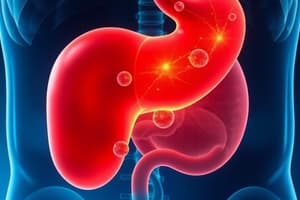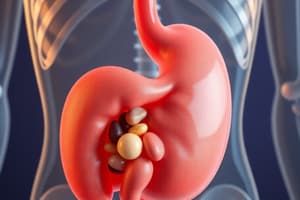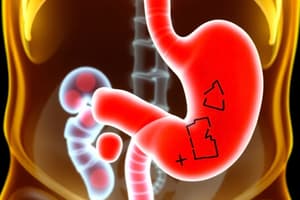Podcast
Questions and Answers
A multiparous woman over 40 presents with right upper quadrant pain radiating to her right shoulder, nausea, and a positive Murphy's sign. Which of the following risk factors most likely contributes to her symptoms?
A multiparous woman over 40 presents with right upper quadrant pain radiating to her right shoulder, nausea, and a positive Murphy's sign. Which of the following risk factors most likely contributes to her symptoms?
- Regular consumption of a low-fat diet
- Vitamin D deficiency
- History of hypothyroidism
- Elevated serum cholesterol levels (correct)
A patient with cholecystitis develops a sudden onset of diffuse abdominal tenderness and rigidity. Which of the following complications is most likely occurring?
A patient with cholecystitis develops a sudden onset of diffuse abdominal tenderness and rigidity. Which of the following complications is most likely occurring?
- Acute pancreatitis
- Cholangitis
- Choledocholithiasis
- Peritonitis (correct)
A patient is scheduled for a cholecystectomy. Which of the following pre-operative nursing interventions is most important to implement?
A patient is scheduled for a cholecystectomy. Which of the following pre-operative nursing interventions is most important to implement?
- Administering fluid and electrolytes (correct)
- Encouraging ambulation to prevent deep vein thrombosis
- Initiating a clear liquid diet
- Providing education on incentive spirometry
A patient taking oral contraceptives is being evaluated for right upper quadrant pain. How do oral contraceptives increase the risk of gallstone formation?
A patient taking oral contraceptives is being evaluated for right upper quadrant pain. How do oral contraceptives increase the risk of gallstone formation?
During an assessment of a patient with suspected cholecystitis, which assessment finding would indicate a positive Murphy's sign?
During an assessment of a patient with suspected cholecystitis, which assessment finding would indicate a positive Murphy's sign?
A patient with cholelithiasis develops a blockage of the pancreatic duct. Which of the following complications is most likely to occur?
A patient with cholelithiasis develops a blockage of the pancreatic duct. Which of the following complications is most likely to occur?
A patient with a history of cholecystitis reports experiencing bloating, heartburn, and flatulence, especially after eating fatty foods. What is the most likely cause of these symptoms?
A patient with a history of cholecystitis reports experiencing bloating, heartburn, and flatulence, especially after eating fatty foods. What is the most likely cause of these symptoms?
Following a laparoscopic cholecystectomy, a patient reports pain in the right shoulder. What is the most likely cause of this pain?
Following a laparoscopic cholecystectomy, a patient reports pain in the right shoulder. What is the most likely cause of this pain?
Flashcards
Cholecystitis
Cholecystitis
Inflammation of the gallbladder.
Cholelithiasis
Cholelithiasis
Small stones, often cholesterol, in the gallbladder.
Cholelithiasis Complication: Acute Pancreatitis
Cholelithiasis Complication: Acute Pancreatitis
Blockage of pancreatic duct leads to inflammation of the pancreas.
Bile Duct Infection (Cholangitis)
Bile Duct Infection (Cholangitis)
Signup and view all the flashcards
Cholecystitis Pain
Cholecystitis Pain
Signup and view all the flashcards
Cholecystitis Symptoms: Pain After Eating
Cholecystitis Symptoms: Pain After Eating
Signup and view all the flashcards
Positive Murphy's Sign
Positive Murphy's Sign
Signup and view all the flashcards
Peritonitis from Gallbladder Perforation
Peritonitis from Gallbladder Perforation
Signup and view all the flashcards
Study Notes
- Cholecystitis is the inflammation of the gallbladder.
- Cholelithiasis refers to small stones, typically made of cholesterol, that form in the gallbladder or common bile duct.
Potential Complications
- Acute pancreatitis can occur if a gallstone blocks the pancreatic duct, leading to inflammation.
- Bile duct infection (cholangitis) is the inflammation of the bile duct caused by a bacterial infection due to blockage.
- Prolonged bile duct obstruction can result in liver damage.
Risk Factors for Cholecystitis
- Being a female client over 40 years of age increases the risk.
- Multiparous women, those who have given birth to more than one child, are at higher risk.
- The use of oral contraceptives, containing estrogen and progesterone, elevates the risk of gallstones by increasing cholesterol levels in bile.
- Elevated serum cholesterol levels can contribute to this condition.
- Increased estrogen in the body, which increases cholesterol secretion in the biliary duct, is also a factor.
- Family history of cholecystitis raises one's susceptibility.
Common Signs and Symptoms
- Colicky pain in the right upper quadrant (RUQ) is due to the gallbladder attempting to contract to release bile.
- Pain may radiate to the right shoulder and the back.
- The pain intensifies approximately 30 minutes after the gallbladder attempts to release bile.
- Experience of nausea and vomiting are common.
- Localized guarding in the abdomen may be present.
- Positive Murphy Sign is indicative of cholecystitis; pain occurs upon palpation of the right side of the rib cage during a deep breath if the gallbladder is inflamed.
- Fever and tachycardia (fast heart rate) may occur.
- Leukocytosis, an elevated white blood cell count, can be present.
Perforation
- A complication is peritonitis, characterized by diffuse abdominal tenderness and rigidity, requiring immediate medical attention.
- Perforation of the gallbladder causes bile leakage into the abdominal cavity, irritating muscles and causing rigidity, with a high risk of bacterial growth leading to sepsis.
- Patients report a history of indigestion when consuming fatty foods.
- Symptoms of indigestion include bloating, heartburn, or flatulence.
Nursing Intervention
- An abdominal ultrasound is used to confirm the diagnosis.
- Surgery, known as cholecystectomy (either laparoscopic or open), is performed.
Pre-Operative Care
- Pain Management with prescribed opioids, or NSAIDs.
- Administer fluids and electrolytes, especially if vomiting.
- Administer IV antiemetics.
- IV antibiotics prophylaxis may be given.
- The client should be kept on NPO (nothing by mouth).
Postoperative Care
- Ambulation is encouraged to reestablish peristalsis and prevent bowel obstruction.
- Increase fluid intake when appropriate.
- Start with a low-fat diet initially, progressing to a regular diet after a few weeks.
Studying That Suits You
Use AI to generate personalized quizzes and flashcards to suit your learning preferences.




